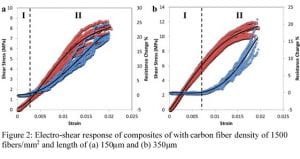Research
Damage sensing in Multi-functional Natural Fiber Composites
This project is sponsored by National Science Foundation (CMMI-1563040). In the recent past, natural fiber composites have been used in structural load bearing applications. Natural fibers are biodegradable and sustainable and hence they reduce carbon foot print when compared to traditional carbon and glass fibers. To make natural fiber composites more attractive, our group makes them multi-functional by embedding carbon nanotubes (CNTs) in the epoxy matrix of the composite and by reinforcing micron-sized carbon fibers between the jute fiber laminates.  The CNTs and carbon fibers generate three dimensional conductive network. Addition of short carbon fibers also improves fracture toughness by crack bridging while helping to detect the damage in these composites. This change of this network is determined using novel four circumferential probe measurement system under mechanical and fracture loading conditions.The initial electrical resistivity of composites made using three different weight percentages of CNTs (0%, 0.025% and 0.1%), two different carbon fiber lengths (150µm and 350µm), four different carbon fiber flock densities (500, 1000, 1500 and 2000 fibers/mm2) and two different laminates’ orientations ((0-0-0-0)T and (0-90-0-90)T) on the resistivity values of the composites is shown in below Figure 1. In this study, experimental studies were conducted on these multi-functional composites under quasi-static shear, fracture, and bending loading of curved geometries. A typical resistance change under shear loading and fracture conditions can be seen in below Figures 1 and 2.
The CNTs and carbon fibers generate three dimensional conductive network. Addition of short carbon fibers also improves fracture toughness by crack bridging while helping to detect the damage in these composites. This change of this network is determined using novel four circumferential probe measurement system under mechanical and fracture loading conditions.The initial electrical resistivity of composites made using three different weight percentages of CNTs (0%, 0.025% and 0.1%), two different carbon fiber lengths (150µm and 350µm), four different carbon fiber flock densities (500, 1000, 1500 and 2000 fibers/mm2) and two different laminates’ orientations ((0-0-0-0)T and (0-90-0-90)T) on the resistivity values of the composites is shown in below Figure 1. In this study, experimental studies were conducted on these multi-functional composites under quasi-static shear, fracture, and bending loading of curved geometries. A typical resistance change under shear loading and fracture conditions can be seen in below Figures 1 and 2.
The peer-reviewed journal publications resulted from this project:
1. Yang, S., Chalivendra, V. (2020) “Theoretical modeling and experimental validation of electro-shear behavior of carbon nanotubes embedded epoxy nanocomposite,” International Journal of Mechanical Sciences, 177, 105594.
2. Yang, S., Meninno, C., Chalivendra, V., Kim, Y., (2020) “Electro-bending Behavior of Curved Natural Fiber Laminated Composites,” Composite Structures, 238, 112004. https://doi.org/10.1016/j.compstruct.2020.112004.
3. Yang, S. Chalivendra, V., Kim, K. (2019) “Electro-fracture Studies of Natural Fiber Composites,” Journal of Natural Fibers, https://doi.org/10.1080/15440478.2019.1685425.
4. Yang, S., Chalivendra, V., Kim, Y. (2018) “Damage sensing in multi-functional hybrid natural fiber composites under shear loading,” Smart materials and Structures, 27, 115034.
5. Yang, S. Chalivendra, V.B. Benjamin, E., Kim, Y. (2019) “Electrical Response of Novel Carbon Nanotubes Embedded and Carbon Fiber Z-axis Reinforced Jute/Epoxy Laminated Composites,” Polymer Composites, 50, E1189-E1198.
6. Meninno, C., Chalivendra, V. Kim, Y. (2020) “Electro-flexure Response of Multi-functional Natural Fiber Hybrid Composites,” Journal of Reinforced Plastics and Composites. DOI: 10.1177/0731684420957396.
Static and Dynamic Fracture of additively manufactured polymers
In this study, the effect of printing orientation and surface topography of additively manufactured or 3D printed Acrylonitrile butadiene styrene (ABS) polymers on static and dynamic fracture toughness was determined. A single edge notched specimen configuration is considered and three orientations, namely horizontal builds with 45°/-45° (H45), 0°/90° (H90) raster orientations, and vertical builds with layers perpendicular to the pre-crack (V0) were studied. A modified split Hopkinson pressure bar is used to conduct the three point bend impact experiment to characterize the dynamic fracture toughness and crack dynamics of 3D printed parts. A high speed camera was used to capture real-time crack initiation and propagation. Using the load history diagram, accurate fracture initiation load is found to determine dynamic fracture initiation toughness. Fracture initiation toughness is increased by 138% for a V0 specimen configuration compared to H90. Introducing of the surface pattern increases the fracture toughness by 58% as compared to the without pattern. Additionally, higher fracture initiation toughness is also achieved with the increasing the size and change of the pattern shape from circle to square. The high-speed images of propagating crack is shown in Figure 4.
The peer-reviewed journal publications resulted from this project:
1. Rabbi, M.F., Chalivendra, V.B., Li, D. (2019) “A Novel Approach to Increase Dynamic Fracture Toughness of Additively Manufactured Polymer,” Experimental Mechanics, Doi.org/10.1007/s11340-019-00486-3.
2. Li, J., Yang, S., Li, D., Chalivendra, V. (2018) “Numerical and experimental studies of additively manufactured polymers for enhanced fracture properties,” Engineering Fracture Mechanics, 204: 557-569.
3. Rabbi, M.F., Chalivendra, V. (2020) “Strain and damage sensing in additively manufactured CB/ABS polymer composites,” Polymer Testing, 90, 106688.
4. Rabbi, M.F.. Chalivendra, V. (2021) “Interfacial Fracture Characterization of Multi-Material Additively Manufactured Polymer Composites,” Composites Part C: Open Access. https://doi.org/10.1016/j.jcomc.2021.100145.
5. Rabbi, M.F., Chalivendra, V.B. (2021) “Improvement in Interfacial Fracture Toughness of Multi-Material Additively Manufactured Composites Through Thermal Annealing,” Forces in Mechanics, 5, 100051. https://doi.org/10.1016/j.finmec.2021.100051
6. Letizia, J., Chalivendra, V., Li, D. (2022) “Effect of Shear Angle and Printing Orientation on Shear Constitutive Response of Additively Manufactured Acrylonitrile Butadiene Styrene,” Polymers, 14, 2484. https://doi.org/10.3390/polym14122484



